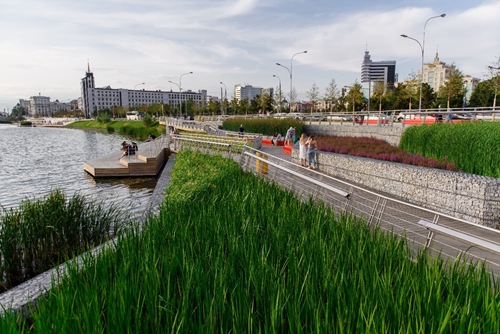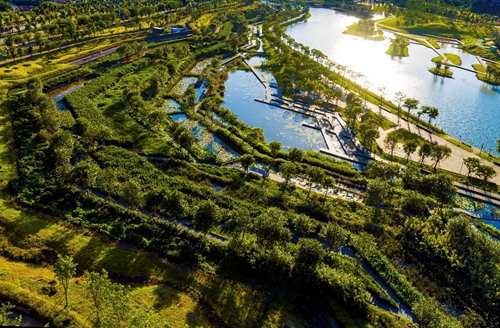Peking University, January 4, 2019: The last issue of Scientific American in 2018 published a review article on sponge city, a new stormwater management method. Based on the author Erica Gies’ field investigation, the article introduces Professor Yu Kongjian’s team’s theories and findings on sponge city, and subsequent pilot practices.
The article praises Yu Kongjian as a pioneer of the global movement to recover the natural water circulation. Erica Gies points out that Yu Kongjian aims at a non-engineering water system management. In allowing water for more space to flow freely and slowly, a higher percentage of water seeps into the ground. This underground water could be used to alleviate water shortages in dry seasons. The facilities could also help to restore wildlife habitats, build greenways for pedestrians and cyclists, and establish green cultural heritage corridors.
Although in the past, Yu Kongjian’s idea, which draws from farmers’ knowledge to deal with ecological problems, has been doubted, the general view is changing nowadays. A multitude of Chinese groups are building green infrastructures and collaborating with Australians and Europeans. Yu Kongjian has been gaining an increasing influence.
The Sponge City Movement is thriving. The method is specially recommended in United Nations World Water Development Report 2018: Nature-based Solutions for Water Resources. Similar projects have also been conducted by the US Army Corps of Engineers and the Dutch government.
Yanweizhou Park in Jinhua, Zhejiang

Kaban Lakes in Russia

Meishe River in Haikou, Hainan
Yu Kongjian:
Yu has been professor of Urban and Regional Planning at Peking University since 1997. He is famous for being the pioneer who reintroduced ancient Chinese water systems to modern design and best known for his “sponge city” theories. His team has designed a series of reproducible engineering examples, applying their theories of sponge city to the ecological reconstruction of more than 200 cities in over 10 countries. His constructions not only successfully resolve environmental problems, but also win global acclaim for their perfect combination of ecology and art. The works of Yu’s team have won the ASLA for 13 times, the World Architectural Festival Awards of Landscape (WAF) for 5 times, and more than 20 pieces of his works have been included in the textbooks of European and American universities. Yu himself was elected as member of the American Academy of Arts and Sciences in 2016. In the same year, he was also awarded an honorary doctorate degree by the University of Rome.
Scientific American:
In publication since 1845, Scientific American has been delivering breaking and in-depth news in science and technology and how they are shaping our future. Scientific American is geared towards an educated, general audience with an interest in issues within the field, as its forum of theories and discoveries are explained in an accessible and approachable fashion. Every issue presents the most riveting and fascinating work being conducted in areas such as medicine, technology, energy, the environment, and business. Scientific American is also well-known for its constant accuracy in foreseeing advances and leaps on a broad range of topics within both the physical and social sciences. This monthly magazine dynamically presents the remarkable efforts of world-renowned scientists and Nobel laureates.
Written by: Wang Xi
Edited by: Huang Yandan


